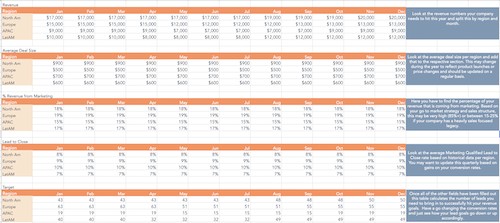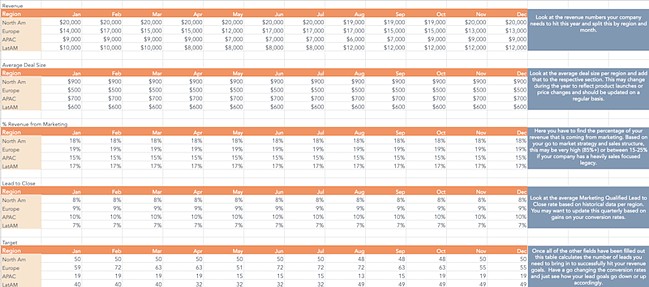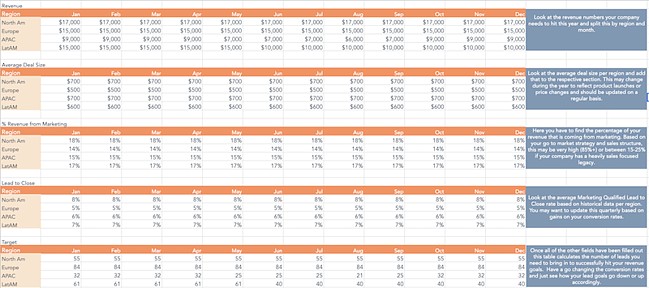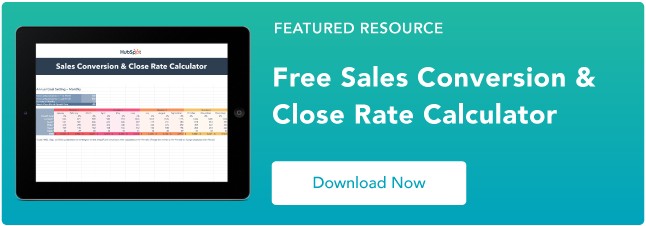To hit revenue and growth goals, your company needs customers. To get customers in an inbound world, your marketing team is responsible for generating leads and funneling them over to your sales team. The question is ... how many leads?
When your boss asks you what your lead goal is, don't just pull an answer out of thin air. Your projections need to be based on math and anchored in your company's larger goals. That's where our new lead goal calculator comes in.
Lead Calculator
To make it easier for marketers like you to set your lead goals for the month, we created a calculator template in Google Sheets and Excel that will calculate exactly how many leads your inbound marketing efforts need to drive each month for your sales organization to hit their numbers and your company to meet its growth goals. With just a few quick inputs, like your monthly revenue goal and average deal size, this template will do all the Math for you.
Our lead generation goal calculator is a customizable Service Level Agreement (SLA) template that can help you calculate your lead goals based on sales headcount and marketing & sales conversion rates. The template can also monitor sales close rates, assign dollar values to each of your lead sources, track monthly lead generation by channel, and help your business commit to a concrete monthly lead generation goal.
You can download the Lead Goal Calculator here.
How to Use A Lead Goal Calculator
To use the Lead Goal calculator, follow these simple steps:
- Step 1: Work with your sales leadership team to determine the overall monthly revenue target that your company needs to hit. This will ensure that marketing acts as a growth engine and your revenue team is in line with sales. Take your revenue targets per region per month and add them to the correct cells. Remember to update this spreadsheet if your goals change at any point throughout the year.
- Step 2: Determine the value of your average deal size. This will help you determine how many deals you need to close to hit your revenue numbers. Calculating your average deal size is simple. First, identify your average sale price for each of your core regions or personas. Find this data in your marketing software and sales CRM tools. Input your average sale value into the top "average sale price" row for each region. Our template will automatically calculate the value of your leads based upon the % close rates you filled in for step one. Revisit your average sale prices for your personas or regions regularly to make sure you are holding your teams to the right numbers.
- Step 3: Work with your sales leadership to determine the percentage of revenue pipeline generated by marketing and the revenue generated directly by sales. This will vary depending on how inbound versus outbound your company is. This may change throughout the year and should regularly be updated in this spreadsheet.
- Step 4: Examine your sales closing rates, and specifically tease out what percentage of your leads ultimately become customers. This analysis looks at the historical performance in your marketing and sales, In addition, this analysis fills these holes in with actual performance data. To tease out your overall closing rates, look at your last six months of sales data for each channel that you use to generate marketing leads.
- Step 5: The last section of our calculator will tally your commitments. As you fill in steps one through three, the calculator will automatically populate the total fields for each channel and persona. This worksheet will sum up your channel and persona goals and your overall monthly total. Ultimately, the total monthly goal you commit to should equal the total potential revenue each segment or region can produce per month. As you fill out your tables each month, the calculator will show how you are tracking towards your monthly goal.
It's important to adapt this spreadsheet to meet your individual needs. It may work better to split your revenue by personas. If this is the case, just swap out the region for persona. The calculations will still work.
Take the average close rate and add it to the correct cell in the document. Remember to update this spreadsheet every month, as your channel performance will change over time.
In the Performance Against Plan tab, you’ll track your daily actual leads and track monthly volume trends and percentage performance against plan.
The Performance Against Plan Example shows a snapshot of a month’s productivity. For maximum visibility, update these leads on an ongoing basis. For example, HubSpot managers often monitor these numbers daily, and we send the marketing team a daily summary of our month-to-date performance.
You can also use this template to experiment. For example, try changing the conversion rates and see how your lead goals go down or up accordingly.
Lead Calculator Examples
With our Lead Goal Calculator template, you can easily calculate your business’s marketing and sales lead goals for different media channels, including your social media, website, and email marketing.
As shown in the examples below, our calculator will guide you through how to fill in the data for your revenue, average deal size, percentage of revenue from marketing, and lead to close rate in the Lead Target by Month tab. Once this data is entered, the calculator will determine the number of leads you need to bring in to hit your revenue goals successfully.
1. Performance Against Plan
The Performance Against Plan tab will automatically populate and calculate your total target per month for all of your segments. The Performance Against Plan tab also provides a table that you can manually fill in with your business’s actual qualified lead volume every month, so you can track your progress every month and identify volume trends. After filling in the table, the number of leads you need to bring in to hit your revenue goals will be calculated automatically.
2. Leads From Social
You can use our Lead Goal Calculator to determine how many prospects your business needs to connect with on social media in each region to generate leads and meet your sales goals each month.
The calculator can also help you keep track of the amount of monthly revenue you earn through social media posts and advertising, as well as the average size of deals that your business gains through social media each month. In addition, the calculator can help you determine the average percentage of revenue your business gains through social media each month and your average Marketing Qualified Lead to Close rate based on historical data per region.
3. Leads From Website
You can use our Lead Goal Calculator to determine how many prospects your business needs to connect with on your website in each region to generate leads and meet your sales goals. Our calculator can also help you track revenue per month on your SaaS or e-commerce website.
4. Leads From Email
You can use our Lead Goal Calculator to determine what percentage of your business’s revenue should come from email marketing month-by-month. The calculator can also determine how many prospects in each region need to opt-in to receive your business’s marketing emails to generate leads and meet your sales goals.
Start Calculating Your Sales Goals
Our Lead Goal Calculator has everything your business needs to visualize your lead target per month, and this tool calculates your lead goals and sales goals throughout the year.
Editor's note: This post was originally published in January 2017 and has been updated for comprehensiveness.





